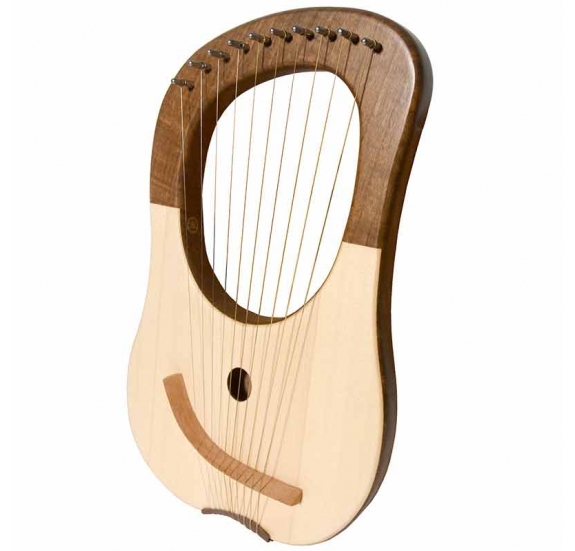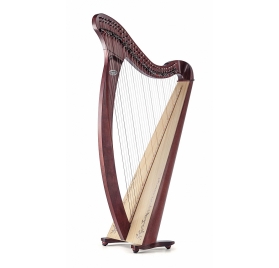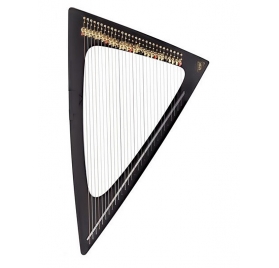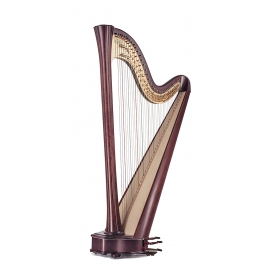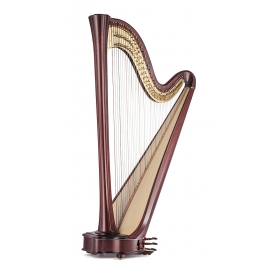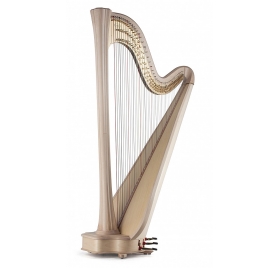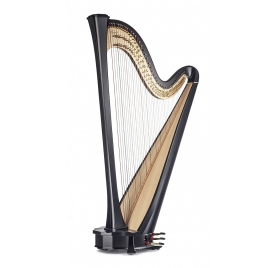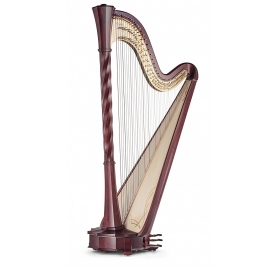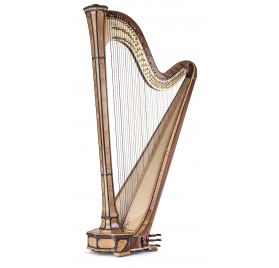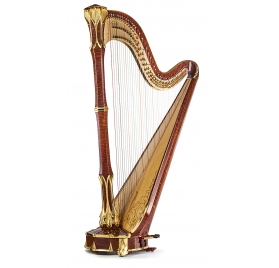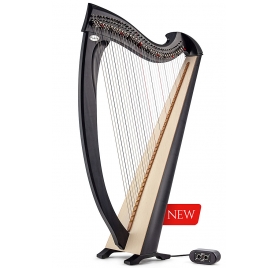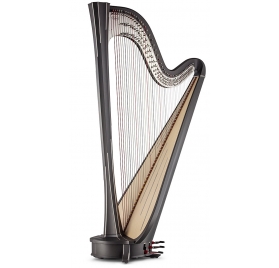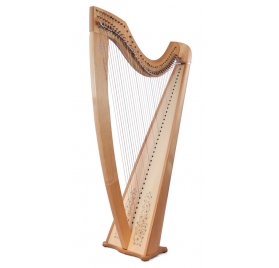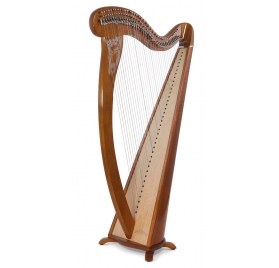Product successfully added to your shopping cart
Quantity
Total
There is 1 item in your cart.
Total products
Total shipping
To be determined
Tax
0 Ft
Total
Continue shopping
Proceed to checkout
Dió vagy rózsafa 10 húros líra hárfa
- Write a review
LYR104
Please inquire for the current price!
This product is no longer in stock
Warning: Last items in stock!
Availability date:
10 string Lyre Harp. The solid Rosewood or walnut body lends itself to the soft gentle curves of this ten string lyre. Moreover, the ten metal strings provide a classical sound that is enhanced by the solid spruce soundboard. AS like when you are not playing, you can hang it up as a piece of art; it’s that pretty.
Accessories Included:
Harp Tuning Tool, Small (code HPTS); Gig Bag; and Extra string set.
To Play: Hold it upright on your lap or as you walk, and pluck both sides of the strings. As or lay it flat and pluck it.
History and Tuning:
In the early Middle Ages in Eastern Europe, the secularization of the Jewish worship music gave rise to Klezmer music. Jewish troubadours, known as klezmorim gave the music a place in weddings and other simkhes (joyful events). In short, the Klezmer music eventually overall blended with Slavonic, Greek, Turkish, Gypsy and even like American jazz tempos and rhythms. For Klezmer Music try the Misheberakh mode which is: E F# G A# B C# D E F# G
A more authentic tuning derives from Judaic worship music, where the instrument was used to accompany the singing of the Chazzan, also known as a Cantor. This style of tuning uses the Chazzanut mode; starting with the bass (largest strings) tune as follows: D E F G# A B C D E F.
Two alternative methods of tuning that work well with singers comfortable in the Key of G are: (again bass to treble): E F# G A B C D E F# G and D E F# G A B C D E F# (E is tonic) after all Notice, in the second tuning, all the notes are the same but you’re starting on D rather than E. However, try an inspirational tuning of your choice.
| Strings | 10 strings |
Related Products
‹
›
In Stock
In Stock
In Stock
In Stock
In Stock
In Stock
In Stock
In Stock
In Stock
In Stock
In Stock
In Stock
In Stock
In Stock
In Stock
In Stock
In Stock
In Stock
In Stock
In Stock
In Stock
In Stock
In Stock
In Stock
In Stock
In Stock
In Stock
In Stock
Salvi Donegal 34 húros kampós hárfa
Donegal
PROFESSIONAL LEVER HARPS
Donegal represents the revival of the Celtic harp tradition. This instrument is ideal for folk music; it is lightweight, portable and fitted with professional levers and the option of interchangeable legs. The carbon fibre strings are low tension and create a crystal, clear and well balanced sound.
1 879 000 Ft
Salvi Una 38 húros kampós hárfa
Una
PROFESSIONAL LEVER HARPS
Lightweight and portable, the new 38-string Una features a sophisticated and captivating Celtic design. Its unique Silkgut® Copper strings containing copper powder from 4th octave B to 5th octave D remove any musical “jump” from wire to non-wire strings, and lend to the Una’s indulgence of rich tones and deep bass.
1 778 000 Ft
Salvi Ana 40 húros kampós hárfa
Ana
PROFESSIONAL LEVER HARPS
A quality choice for students wanting to progress to a pedal harp and for harpists looking for a sound similar to a small pedal harp.
2 794 000 Ft
Salvi Delta 29 húros elektromos kampós hárfa
The harp reinvented
The Delta puts together centuries of traditional craftsmanship into a solid body with cutting-edge audio technology for a professional sounding instrument with smooth playability.
2 258 000 Ft
Salvi Daphne 40 húros pedálos hárfa
Loved by students and appreciated by professionals. In one word: Daphne. A perpetual presence in the Salvi catalogue, this series offers instruments which are sought after for their manageability and the high quality of sound.
6 385 000 Ft
Salvi Daphne 47S pedálos hárfa
Loved by students and appreciated by professionals. In one word: Daphne. A perpetual presence in the Salvi catalogue, this series offers instruments which are sought after for their manageability and the high quality of sound.
6 889 000 Ft
Salvi Daphne 47SE pedálos hárfa
Loved by students and appreciated by professionals. In one word: Daphne. A perpetual presence in the Salvi catalogue, this series offers instruments which are sought after for their manageability and the high quality of sound.
7 396 000 Ft
Salvi Daphne 47EX pedálos hárfa
Loved by students and appreciated by professionals. In one word: Daphne. A perpetual presence in the Salvi catalogue, this series offers instruments which are sought after for their manageability and the high quality of sound.
8 750 000 Ft
Salvi Arion SG pedálos hárfa
A perfect blend of class and comfort from Salvi Harps. The unique design of the soundboard gives a projecting and balanced sound to a harp which is elegant and portable.
8 396 000 Ft
Salvi Arion SG Gold 47 húros pedálos hárfa
The elegance of the Arion SG “Gold” is enhanced by the polished finish, gilding and brass decorations*, while maintaining the same characteristics of sound excellence and portability.
9 556 000 Ft
Salvi Aurora 47 húros professzionális...
Simple elegance and understated lines united with the quality of sound that surpasses the demands of any concert harpist. These are the characteristics of a timeless model by Salvi.
10 918 000 Ft
Salvi Apollo 47 húros professzionális...
The perfect balance of technology and tradition, this harp stands out due to the innovative concept of its sound box and soundboard, offering unique forms of expression. This harp represents Salvi’s ultimate equilibrium of harmony and power.
13 185 000 Ft
Salvi Diana 47 húros professzionális...
Art in the form of a harp: refined sculpture, a hand-decorated soundboard, intricate details. A Salvi jewel loved by all with a legendary sound.
13 689 000 Ft
Salvi Minerva Natural 47 húros...
The unique elegance of the Minerva Natural is a combination of a masterful sculpture and the bright natural beauty of the wood. Volume, projection and tonal beauty meet harpists looking for a magnificent instrument from all aspects.
18 776 000 Ft
Salvi Iris Natural 47 húros...
Art, music, design, research, summing up a perfect harmony in the Iris Natural. The finesse of the sculpture enhances the natural beauty of the wood and gives style and personality to this harp. Beauty is combined with excellent performance. The tonal richness and extraordinary sound projection make it the ideal harp for soloists and orchestras.
19 275 000 Ft
Salvi Arianna 47 húros prémium pedálos hárfa
Eye-catching woods are selected from all corners of the globe for these splendid inlays: from rosewood to olive, from ebony to maple. A harp as magnificent and original as its sound.
20 833 000 Ft
Salvi Diva 47 húros prémium hárfa
Written in its name, Diva’s destiny is to dominate the scene. Charming and modern, simultaneously airy and solid, with a never-before-seen design. The daring and enveloping shapes held together by a fine platinum core, in its Platinum version, collect the best of the technical progress achieved by Salvi Harps research, conceived for performances soaring...
20 588 000 Ft
Salvi Minerva Gold 47 húros prémium...
The dream of every harpist, this jewel of Salvi craftsmanship is enriched with 23-carat gold leaf decorations. Its aesthetic perfection only serves to enhance its full-bodied and vigorous sound, perfect for orchestras and performers who demand the best instruments to enchant audiences worldwide.
30 695 000 Ft
Salvi Iris Gold 47 húros prémium pedálos...
This majestic harp is finely sculpted and glows in the light of 23-carat gold. A resounding timbre and captivating aesthetics make this prestigious Salvi harp the ideal instrument for orchestras and discerning soloists. A limited edition work of art, unique and inimitable.
31 230 000 Ft
Salvi Apollonia 47 húros prémium pedálos...
A passion for beauty that has always been expressed through the Salvi name is embodied in this instrument of formidable emotional impact and personality. Its stunning form seems to breathe a rich and powerful sound.
44 960 000 Ft
Salvi Victoria Gold 47 húros prémium...
Gold, Canadian Hard Maple and skillful manufacturing make Victoria Gold an authentic work of art.
79 360 000 Ft
Salvi Reus 49 húros prémium pedálos hárfa
REUS 49 is an innovative extra-large harp that took four years of research and development. Its dimensions were increased in all: height, number of strings (49, down to 7th Oct. A) and the extension of the sound box and soundboard.
Please inquire for the current price!
38 335 000 Ft
Camac Telenn lever harp
In response to feedback from teachers and partners, the Camac Telenn has recently been redesigned. It has a new soundboard, new curve of the neck, new string lengths, and a new tension. Now strung with light gut, the tension is softer and the pull is lighter, ideal both for child students, and for the folk harpist.
1 285 000 Ft
Camac Hermine lever harp
Created in 2003 following requests from harp teachers, the Hermine is an excellent student lever harp. Its small size and light weight make it particularly suitable for younger players.
1 159 000 Ft
Camac Melusine lever harp
Now over forty years old, the Mélusine enjoys a distinguished reputation. With its design inspired by the first Camac lever harp, it is considered more than ever to be a benchmark in its field, and is the choice of many music schools and conservatoires.
1 285 000 Ft
Camac Isolde Celtic lever harp
Timeless appearance, beautifully light Alliance® strings, and a clear sound make the Celtic Isolde a dream harp for traditional music.
1 428 000 Ft
Camac Isolde Classic lever harp
A homage to Wagner’s famous opera, the Classical Isolde is the quintessence of our master craftsmen’s passionate work. This superbly constructed harp is equipped with Kürschner® fluorocarbon strings.
1 428 000 Ft
Camac Melusine Concert lever harp
The Concert Mélusine is Camac’s best nylon-strung lever harp: of premium wood, made to the highest aesthetic and acoustic standards. It is a harp for soloists who desire a strong, round tone, without sacrificing the clarity of a traditional folk sound.
1 825 000 Ft

